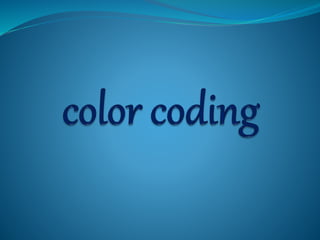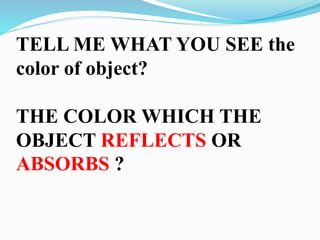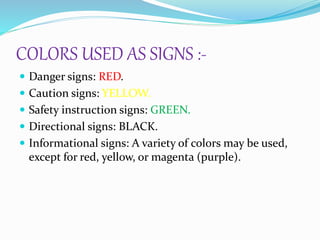Color coding
- 2. Color:- ? It is the visual perceptual property corresponding in humans to the categories called red, blue, yellow, green and others. Color derives from the spectrum of light(distribution of light power versus wavelength) interacting in the eye with the spectral sensitivities of the light receptors. Color categories and physical specifications of color are also associated with objects or materials based on their physical properties such as light absorption, reflection, or emission spectra.
- 3. Electromagnetic radiation is characterized by its wavelength (or frequency) and its intensity. When the wavelength is within the visible spectrum (the range of wavelengths humans can perceive, approximately from 390 nm to 700 nm), it is known as "visible light". The colors of the visible light spectrum[1] color wavelength interval frequency interval red ~ 700ĻC 635 nm ~ 430ĻC 480 THz orange ~ 635ĻC 590 nm ~ 480ĻC 510 THz yellow ~ 590ĻC 560 nm ~ 510ĻC 540 THz green ~ 560ĻC 490 nm ~ 540ĻC 610 THz blue ~ 490ĻC 450 nm ~ 610ĻC 670 THz violet ~ 450ĻC 400 nm ~ 670ĻC 750 THz
- 4. HOW DO OUR EYES SEE color
- 5. When light hits an object ĻC say, a banana ĻC the object absorbs some of the light and reflects the rest of it. Which wavelengths are reflected or absorbed depends on the properties of the object. For a ripe banana, wavelengths of about 570 to 580 nanometers bounce back. These are the wavelengths of yellow light.
- 6. TELL ME WHAT YOU SEE the color of object? THE COLOR WHICH THE OBJECT REFLECTS OR ABSORBS ?
- 7. ?When you look at a banana, the wavelengths of reflected light determine what color you see.
- 8. The light waves reflect off the banana's peel and hit the light-sensitive retina at the back of your eye. That's where cones come in.
- 9. ?Cones are one type of photoreceptor, the tiny cells in the retina that respond to light. Most of us have 6 to 7 million cones, and almost all of them are concentrated on a 0.3 millimeter spot on the retina called the fovea centralis. ?When light from the banana hits the cones, it stimulates them to varying degrees. The resulting signal is zapped along the optic nerve to the visual cortex of the brain, which processes the information and returns with a color: yellow.
- 10. COLORS USED AS SIGNS :- ? Danger signs: RED. ? Caution signs: YELLOW. ? Safety instruction signs: GREEN. ? Directional signs: BLACK. ? Informational signs: A variety of colors may be used, except for red, yellow, or magenta (purple).
- 11. DANGER SIGNS :- Danger signs should only be used when immediate hazard exists. There will be no variations in the type or design of signs posted to warn of specific danger. All personnel will be instructed that danger signs indicate immediate danger and that special precautions are necessary
- 12. CAUTION SIGNS :- Caution signs should be used only to warn against potential hazards or to caution against unsafe practices. All personnel will be instructed that a caution sign indicates a possible hazard against which proper precautions will be taken
- 13. DIRECTIONAL SIGNS :- Directional signs should be used in sufficient numbers to indicate the way to stairways, fire escapes, exits, and other locations. Many other safety media are available for use in military maintenance shops.
- 14. Safety instruction signs: GREEN.
- 15. Contrast:- ? Contrast is the difference in luminance and/or color that makes an object (or its representation in an image or display) distinguishable. In visual perception of the real world, contrast is determined by the difference in the color and brightness of the object and other objects within the same field of view. Because the human visual system is more sensitive to contrast than absolute luminance, we can perceive the world similarly regardless of the huge changes in illumination over the day or from place to place. The maximum contrast of an image is the contrast ratio or dynamic range.
- 16. Changes in the amount of contrast in a photo
- 17. Images of different contrasts:-
- 18. Examples:-
- 20. Color in Interior Design:- Changing a roomĄŊs color can affect the mood
- 21. Importance of color contrast in HFE:- ? If its contrast is poor it leads to poor visibility. ? If machines are not numbered with correct colors there will be lagging in time, as it takes lot of time to identify the machine. ? Manufacturers should see that the colors are aesthetically good. ? When the products are coded with colors they should see that the colors are not to bright or too low to see them. ? When a worker who continuously works on a machine ,which is not correctly coded with colors then he would be stressed or feel fatigue or irritated which directly shows affect on production.
- 22. Taking color contrast into account is must in Human Factors Engineering.



![Electromagnetic radiation is characterized by its wavelength (or frequency) and its intensity. When
the wavelength is within the visible spectrum (the range of wavelengths humans can perceive,
approximately from 390 nm to 700 nm), it is known as "visible light".
The colors of the visible light spectrum[1]
color
wavelength
interval
frequency
interval
red
~ 700ĻC
635 nm
~ 430ĻC
480 THz
orange
~ 635ĻC
590 nm
~ 480ĻC
510 THz
yellow
~ 590ĻC
560 nm
~ 510ĻC
540 THz
green
~ 560ĻC
490 nm
~ 540ĻC
610 THz
blue
~ 490ĻC
450 nm
~ 610ĻC
670 THz
violet
~ 450ĻC
400 nm
~ 670ĻC
750 THz](https://image.slidesharecdn.com/colorcoding-141120232809-conversion-gate01/85/Color-coding-3-320.jpg)


















